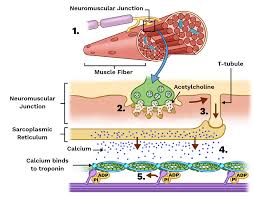Back to: ZOOLOGY 400 Level
Welcome to class!
Hello again, awesome learner! I’m excited that you’re back and ready to dive into another exciting topic. Today, we’re going to explore the mechanisms of muscle contraction and neuromuscular junctions, which is all about how your muscles actually move and how your nerves help make that happen. This is like the behind-the-scenes magic of how your body performs every single movement, from picking up a pencil to running a marathon. Let’s get started!
Mechanisms Of Contraction And Neuromuscular Junctions
What is Muscle Contraction?
Muscle contraction is the process by which muscles generate force to move parts of your body. It’s a coordinated event where the muscle fibres shorten, causing the muscle to contract and produce movement. But how does this happen?
The answer lies in tiny structures within your muscles called myofibrils. Myofibrils contain even smaller structures called sarcomeres, which are the functional units of muscle contraction. Sarcomeres are made of two types of protein filaments: actin (thin filaments) and myosin (thick filaments). When your muscles contract, these filaments slide past each other, shortening the muscle and generating movement.

How Muscle Contraction Happens
Let’s break it down step by step, using the example of a muscle in your arm, like the biceps. When your brain sends a signal to contract the biceps muscle (for example, to lift a heavy object), here’s what happens:
The Signal from the Nervous System
Your brain sends a signal down a nerve, which travels through the spinal cord to the muscle. This signal is in the form of an electrical impulse that travels along the motor neuron (a nerve cell that controls muscles).
The Neuromuscular Junction
The motor neuron’s endpoint connects with the muscle fibre at a special site called the neuromuscular junction (NMJ). This is where the nerve meets the muscle, and it’s crucial for muscle contraction. When the electrical signal reaches the neuromuscular junction, it triggers the release of a neurotransmitter called acetylcholine (ACh).
Activation of Muscle Fibres
Acetylcholine binds to receptors on the muscle fibre’s membrane, causing an electrical impulse to spread across the muscle fibre. This impulse causes the muscle’s internal structures (the sarcoplasmic reticulum) to release calcium ions.
Sliding Filament Mechanism
The calcium ions then bind to the protein troponin, which is attached to the actin filaments. This causes a change in the shape of the actin filaments, allowing myosin heads to attach to the actin and pull them along. This sliding of actin and myosin filaments shortens the sarcomere, causing the muscle to contract.
Muscle Relaxation
Once the brain stops sending signals, acetylcholine is broken down, and calcium ions are pumped back into storage. This causes the actin and myosin filaments to slide back to their original positions, and the muscle relaxes.
Neuromuscular Junction (NMJ)
The neuromuscular junction is the connection between the motor neuron and the muscle fibre. It’s like the communication point where the nervous system talks to the muscles to initiate movement. Without the neuromuscular junction, the muscle wouldn’t know when or how to contract.
At the neuromuscular junction, the following steps occur:
Action Potential: When a signal (action potential) from the brain reaches the motor neuron, it travels down the axon of the motor neuron to the neuromuscular junction.
Release of Acetylcholine: The action potential causes the release of acetylcholine from the motor neuron into the synaptic cleft (the gap between the neuron and muscle fibre).
Muscle Activation: Acetylcholine binds to receptors on the muscle membrane (sarcolemma), triggering a series of events inside the muscle fibre, leading to contraction.
End of the Signal: Acetylcholine is broken down by an enzyme called acetylcholinesterase, which stops the signal, allowing the muscle to relax.
Real-life Example
Imagine you’re picking up a heavy box. Here’s how the process works:

Your brain sends a signal through the spinal cord to the motor neurons in your arm muscles.
At the neuromuscular junction, acetylcholine is released, activating your muscle fibres.
The myosin and actin filaments in your muscle fibres slide past each other, causing the muscle to contract and lift the box.
Once you stop lifting, your brain stops sending signals, and your muscles relax.
Summary
- Muscle contraction is the process by which muscles generate force to produce movement by shortening muscle fibres.
- The contraction involves the sliding of actin and myosin filaments inside the muscle fibre.
- The process begins when the brain sends an electrical signal through motor neurons to the muscle.
- The neuromuscular junction is where the motor neuron communicates with the muscle fibre, using acetylcholine.
- Once the signal ends, muscles relax as calcium ions are pumped back into storage, and actin and myosin return to their original positions.
Evaluation
- What is the role of acetylcholine in muscle contraction?
- Describe the steps of muscle contraction, starting from the brain sending a signal.
- What happens at the neuromuscular junction?
- How does the sliding filament mechanism work to cause muscle contraction?
- What causes muscles to relax after a contraction?
You’re doing an incredible job! Understanding how muscles contract and how they’re controlled by your nervous system is not only fascinating, but it also shows how beautifully coordinated your body is. Keep up the fantastic work, and remember that Afrilearn is here to support you every step of the way. You’re well on your way to mastering this topic and many more! 🌟
